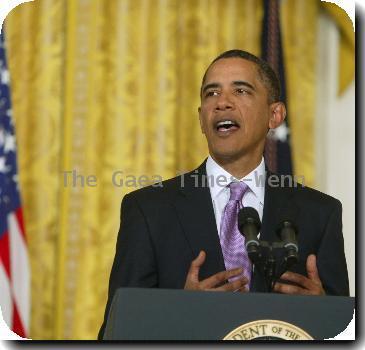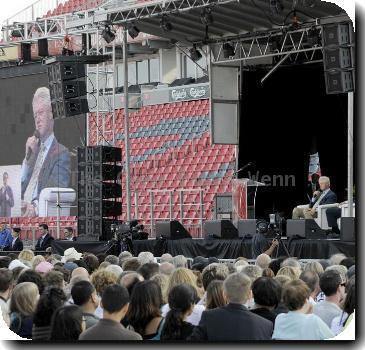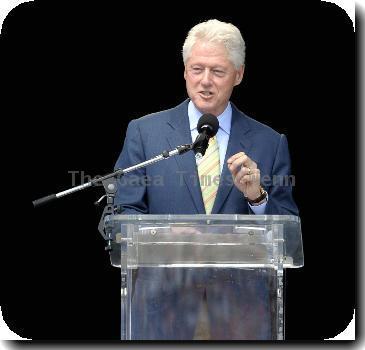7.0 earthquake hits Haiti; hospital and buildings collapse as officials expect many casualties
By Jonathan M. Katz, APTuesday, January 12, 2010
Major quake hits Haiti; many casualties expected
PORT-AU-PRINCE, Haiti — A powerful earthquake struck Haiti’s capital on Tuesday with withering force, toppling everything from simple shacks to the ornate National Palace. The dead and injured lay in the streets even as strong aftershocks rippled through the impoverished Caribbean country.
Associated Press journalists based in Port-au-Prince said the damage from the quake — the most powerful to hit Haiti in more than 200 years — is staggering even in a country accustomed to tragedy and disaster. Thousands of people gathered in public squares late into the night, singing hymns and weeping.
Many gravely injured people sat in the streets early Wednesday, pleading for doctors. With almost no emergency services to speak of, the surivors had few other options.
The scope of the disaster remained unclear early Wednesday, and even a rough estimate of the number of casualties was impossible. But it was clear from a tour of the capital that tens of thousands of people had lost their homes and that many had perished. Many buildings in Haiti are flimsy and dangerous even under normal conditions.
“The hospitals cannot handle all these victims,” said Louis-Gerard Gilles, a doctor and former senator, as he helped survivors. “Haiti needs to pray. We all need to pray together.”
An Associated Press videographer saw a wrecked hospital where people screamed for help in Petionville, a hillside Port-au-Prince district that is home to many diplomats and wealthy Haitians as well as many poor people.
The headquarters of the 9,000-member Haiti peacekeeping mission and other U.N. installations were seriously damaged, according to Alain Le Roy, the U.N. peacekeeping chief in New York.
“Contacts with the U.N. on the ground have been severely hampered,” Le Roy said in a statement, adding: “For the moment, a large number of personnel remain unaccounted for.”
Despite the destruction, the capital was largely peaceful.
The 7.0-magnitude quake struck at 4:53 p.m. Tuesday, leaving large numbers of people unaccounted for, including many of the United Nations personnel who have been keeping the peace in the country since a 2004 rebellion ousted the president.
President Rene Preval and his wife survived the earthquake, according to Robert Manuel, Haiti’s ambassador to Mexico. He said he had no other details.
Karel Zelenka, a Catholic Relief Services representative in Port-au-Prince, told U.S. colleagues before phone service failed that “there must be thousands of people dead,” according to a spokeswoman for the aid group, Sara Fajardo.
“He reported that it was just total disaster and chaos, that there were clouds of dust surrounding Port-au-Prince,” Fajardo said from the group’s offices in Maryland.
State Department spokesman P.J. Crowley said in Washington that U.S. Embassy personnel were “literally in the dark” after power failed.
“They reported structures down. They reported a lot of walls down. They did see a number of bodies in the street and on the sidewalk that had been hit by debris. So clearly, there’s going to be serious loss of life in this,” he said.
The Diocese of Norwich, Connecticut, said at least two Americans working at its Haitian aid mission were believed trapped in rubble.
With phone service erratic, much of the early communication came from social media such as Twitter. Richard Morse, a well-known musician who manages the famed Olafson Hotel, kept up a stream of dispatches on the aftershocks and damage reports. The news, based mostly on second-hand reports and photos, was disturbing, with people screaming in fear and roads blocked with debris. Belair, a slum even in the best of times, was said to be “a broken mess.”
The earthquake had a preliminary magnitude of 7.0 and was centered about 10 miles (15 kilometers) west of Port-au-Prince at a depth of 5 miles (8 kilometers), the U.S. Geological Survey said. USGS geophysicist Kristin Marano called it the strongest earthquake since 1770 in what is now Haiti. In 1946, a magnitude-8.1 quake struck the Dominican Republic and also shook Haiti, producing a tsunami that killed 1,790 people.
The temblor appeared to have occurred along a strike-slip fault, where one side of a vertical fault slips horizontally past the other, said earthquake expert Tom Jordan at the University of Southern California. The quake’s size and proximity to populated Port-au-Prince likely caused widespread casualties and structural damage, he said.
“It’s going to be a real killer,” he said. “Whenever something like this happens, you just hope for the best.”
Most of Haiti’s 9 million people are desperately poor, and after years of political instability the country has no real construction standards. In November 2008, following the collapse of a school in Petionville, the mayor of Port-au-Prince estimated about 60 percent of the buildings were shoddily built and unsafe in normal circumstances.
Tuesday’s quake was felt in the Dominican Republic, which shares a border with Haiti on the island of Hispaniola, and some panicked residents in the capital of Santo Domingo fled from their shaking homes. But no major damage was reported there.
In eastern Cuba, houses shook but there were also no reports of significant damage.
“We felt it very strongly and I would say for a long time. We had time to evacuate,” said Monsignor Dionisio Garcia, archbishop of Santiago.
The damage in Haiti, however, was clearly vast.
“Everybody is just totally, totally freaked out and shaken,” said Henry Bahn, a U.S. Department of Agriculture official visiting Port-au-Prince. “The sky is just gray with dust.
Bahn said there were rocks strewn about and he saw a ravine where several homes had stood: “It’s just full of collapsed walls and rubble and barbed wire.”
In the community of Thomassin, just outside Port-au-Prince, Alain Denis said neighbors told him the only road to the capital had been cut and phones were all dead so it was hard to determine the extent of the damage.
“At this point, everything is a rumor,” he said. “It’s dark. It’s nighttime.”
Jocelyn Valcin, a resident of Boynton Beach, Flordia who flew in to Miami International Airport from Port-au-Prince on Tuesday evening, said he was at the airport when the earthquake hit.
“The whole building was cracked down,” Valcin said. “The whole outside deteriorated.”
Former President Bill Clinton, the U.N.’s special envoy for Haiti, issued a statement saying his office would do whatever he could to help the nation recover and rebuild.
“My thoughts and prayers are with the people of Haiti,” he said.
President Barack Obama ordered U.S. officials to start preparing in case humanitarian assistance was needed.
Venezuelan Foreign Minister Nicolas Maduro said his government planned to send a military aircraft carrying canned foods, medicine and drinking water and also would dispatch a team of 50 rescue workers.
Mexico, which suffered a devastating earthquake in 1985 that killed some 10,000 people, was sending a team including doctors, search and rescue dogs and infrastructure damage experts, said Salvador Beltran, the undersecretary of foreign relations for Latin America and the Caribbean.
Haitian musician Wyclef Jean urged his fans to donate to earthquake relief efforts: “We must think ahead for the aftershock, the people will need food, medicine, shelter, etc.,” Jean said on his Web site.
Eva DeHart at the humanitarian organization For Haiti With Love in Palm Harbor, Florida, said colleagues at the group’s base in Cap Haitien reported that northern town was spared damage. But she said damage to government buildings in the capital would make coordinating aid difficult.
In Miami’s Little Haiti neighborhood, dozens of people gathered at the Veye-Yo community center, where a pastor led them in prayer. Members embraced each other as they tried to contact relatives back home.
Tony Jeanthenor said he had succeeded in reaching a family friend in Haiti who told of hearing people cry out for help from under debris.
“The level of anxiety is high,” Jeanthenor said. “Haiti has been through trauma since 2004, from coup d’etat to hurricanes, now earthquakes.”
Associated Press videographer Pierre Richard Luxama in Haiti and AP writers David Koop and Olga R. Rodriguez in Mexico City; David McFadden and Danica Coto in San Juan, Puerto Rico; Matthew Lee in Washington; Alicia Chang in Los Angeles, Andrea Rodriguez in Havana, Tamara Lush in Tampa, Fla., and Jennifer Kay and Christine Armario in Miami contributed to this report.
Tags: Accidents, Arts And Entertainment, Bahamas, Barack Obama, Bill Clinton, Caribbean, Celebrity, Central America, Class Conflicts, Dominican Republic, Earthquake, Embassies, Emergency Management, Florida, Haiti, Latin America And Caribbean, Mexico, Miami, New York, North America, Port-au-prince, Property Damage, Search And Rescue Efforts, Tsunami watch, Twitter, United States














